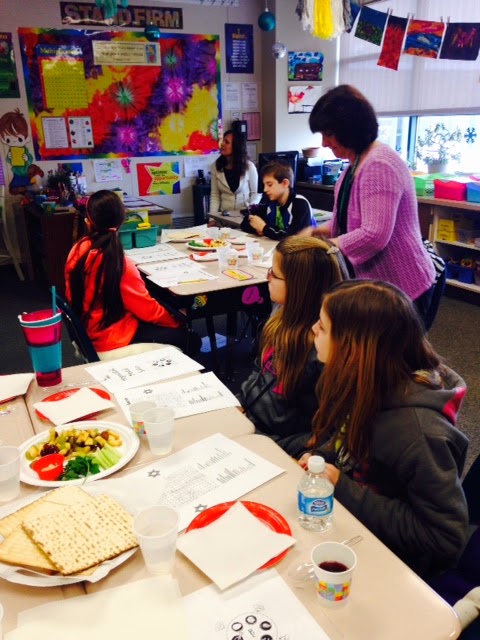Our fifth grade classes traditionally celebrate Passover with
a ritual feast called a Seder. For the
Jewish people, this meal marks the beginning of the Passover holiday.
They were preparing food plates, setting tables
with items like bowls of salt water, and pouring grape juice.
They placed 1 plate in the center of each table group. The plates contained a small bunch of
parsley, 1 spoonful of horseradish, 4 pieces of celery, and 4 spoonsful of
charoset.
Charoset is a chopped apple salad which traditionally
contains fruit, nuts, cinnamon, and wine.
Made by Carter’s mother, it looked delicious! Because the celebration
was taking place in an elementary school classroom, there was no wine and there
were no nuts!
The charoset symbolizes the bricks and mortar the Hebrew slaves
were made to produce during their time as slaves in Egypt.
In preparation for sharing the meal, classroom teacher Mrs.
Swartley read to her students from a book about Passover. She reviewed the symbolic meaning of each element
of the meal. Showing them examples of a
Seder plate, she noted that the item they were seeing in the center of one of the
plates was a horseradish root, NOT a carrot.
Unleavened bread symbolizes the speed with which the Jews
were made to depart Egypt. They could
not wait for their breads to rise when they were fleeing slavery. The matzo is
referred to as both the “bread of affliction” and the “bread of freedom.” One student from each table group broke the
matzo.
At one point during this ritual meal, the storyteller reminds participants about the miraculous salvation of their Jewish ancestors through an enumeration of the ten plagues. So in the case of our fifth graders, each time Mrs. Swartley named a pestilence, students dipped fingers into “wine”, each relocating a drop of fluid onto to his or her plate.
There was lots of tasting.
I’m not sure why our children can identify the flavor lawn, but one of
the students noted that parsley tastes “worse than grass!”
There was a lovely song about God’s kindness. “Dayenu”, the words meaning: It Would Have Been Enough. The singing got a little livelier as the
song grew to its finale with a resounding “HEY!”
The students had various shapes and sizes of cushions upon
which they “reclined” during the feast. For the purposes of the Seder, this comfortable position symbolized freedom. Only free persons are able to relax while servants stand. I particularly enjoyed Keira’s hot-pink fuzzy pillow.
Whether through touch, taste, sound, or visual experience, I
admire the way our teachers work to transform unfamiliar concepts into
something wonderfully tangible. Ideas leap from written page to fond memory by means
of these unforgettable student experiences.














No comments:
Post a Comment